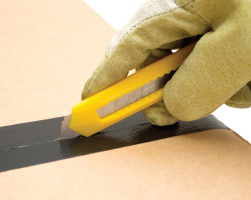- Categories:
How a Safety Retail Audit Can Drop Your Bookseller Risks
Here, LIBRIS insurance encourages booksellers to schedule a regular retail safety audit to help lower their liability.
If you’re an independent bookseller, safety may not be as front of mind as inventory control, staffing, and bookkeeping. But all it takes is one customer with eyes on their phone, a running child, a spilled drink, an elderly person with poor eyesight, or an employee inadvertently blocking an aisle... The list is endless. And so is your potential risk.
That’s why we recommend using a retail safety audit. This checklist is fairly comprehensive, helping you to better keep an eye on potential issues that may impact the safety of your customers, your employees, or yourself.
Download the retail safety audit checklist from LIBRIS now.
HOW TO START YOUR RETAIL SAFETY AUDIT
 A proactive approach can help you prevent most workplace injuries and illnesses. The steps to follow include identifying workplace hazards and finding ways to eliminate or minimize the risks. Involve your workers in the process, as they can offer valuable suggestions.
A proactive approach can help you prevent most workplace injuries and illnesses. The steps to follow include identifying workplace hazards and finding ways to eliminate or minimize the risks. Involve your workers in the process, as they can offer valuable suggestions.
1. Identify hazards in your workplace. Go over every area of your retail space, looking for hazards. For example, you may discover that workers are at risk when lifting heavy boxes of books or walking over a loose threshold or that buckling carpet in the children’s section.
2. Prioritize the risks that each hazard presents. Which hazards should be dealt with immediately, and which ones can you delay for a bit?
3. Control the risks by eliminating or minimizing them. If possible, eliminate the risks completely. If this is unrealistic, minimize the risks as much as possible. The following are examples of risk control:
- Change your workplace design. For example, store extra stock at lower heights so workers don’t have to climb ladders to retrieve it. Put a first aid kit under the register.
- Revise work procedures. For example, owners may want to tell workers to use main entrances, not secluded or rear exits, when leaving work to reduce the potential for incidents of violence.
- Make physical changes to your shop. You may consider adding more lighting or security cameras, replacing the carpeting in the kids’ section, checking store entrances and restrooms for slip hazards, or inspecting the parking lot for uneven pavement or trip hazards. Clearly designate which areas are off-limits to customers.
PROVIDE WRITTEN SAFE-WORK PROCEDURES
It’s a situation common with all retailers: your workforce is fleeting. You may train them in all the procedures, but in just a few months, they’ve left for another job, so safety training can be a real challenge. One option is to provide a short monthly safety bulletin highlighting a different issue each time, from shoplifting to ergonomics. Regardless of how you convey your safety information, be sure you provide clear, written instructions as to how work should be carried out safely, from using special equipment to dealing with shoplifters or working alone. Your written procedures must list any required personal protective equipment, when it must be used, and where workers can find it. Here’s an example:
 Manual Lifting
Manual Lifting
1. Before you lift heavy boxes:
- Keep your feet apart, with one foot along the side and one foot behind the object you are lifting.
- Keep your back straight, nearly vertical.
- Keep your knees bent.
- Use your full palm to grip the object.
- Tuck your elbows in and hold the load close to your body.
2. When lifting:
- Keep your chin tucked in.
- Keep your body weight centered over your feet and the load weight as close to your body as possible.
- Avoid twisting.
- Lift, bringing your back leg forward to provide a smooth transition from lifting to carrying.
- Do not lift loads above chest height.
3. With a good handhold, a one-handed carry is effective for compact objects. You can carry more weight with both hands if your arms are straight in front of your body.
TRAIN YOUR WORKERS
Your written safe-work procedures are an excellent resource during the education and training process. Workers should also be trained in the use of emergency equipment and procedures. They should know the locations of fire exits, fire extinguishers, and first aid kits — and how to use these items.
Start new employees off right by providing all the safety training they’ll need. Worksafebc.com provides these considerations for onboarding new employees:
- Train workers how to safely perform their daily tasks, from carrying and opening boxes to stocking shelves, cleaning, and checkout.
- Inform the worker about potential workplace safety issues, such as how to handle shoplifters or a broken pipe in the restroom.
- Describe how to get first aid and how to report injuries and other incidents.
PERFORM SAFETY INSPECTIONS REGULARLY
 Regular workplace safety inspections will help you assess and control risks to workers. Inspection is an ongoing task, because the workplace is always changing.
Regular workplace safety inspections will help you assess and control risks to workers. Inspection is an ongoing task, because the workplace is always changing.
Watch how work is performed. For example, check that workers are using proper lifting procedures. After the inspection, develop ways to eliminate or minimize any risks you’ve found.
Keeping safety as a top objective will help keep you, your employees, and your customers safe. A commitment to health and safety makes good business sense. Workplace accidents can be financially devastating for a small business when you consider workers’ benefit costs, liability, or damage to property and stock. With a good health and safety program in place, you can focus your efforts on making your business grow.
This article was provided by LIBRIS, the insurance program supported by the ABA, which offers tailored, affordable bookstore coverage.
Have questions on risk, safety inspections, or insurance terms on lease agreements? Want a free, no-obligation insurance quote? Contact LIBRIS today at (888) 694-8585 or [email protected].

